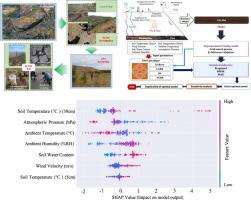当前位置:
X-MOL 学术
›
J. Adv. Res.
›
论文详情
Our official English website, www.x-mol.net, welcomes your
feedback! (Note: you will need to create a separate account there.)
Advanced machine learning schemes for prediction CO2 flux based experimental approach in underground coal fire areas
Journal of Advanced Research ( IF 11.4 ) Pub Date : 2024-11-07 , DOI: 10.1016/j.jare.2024.10.034 Yongjun Wang, Mingze Guo, Hung Vo Thanh, Hemeng Zhang, Xiaoying Liu, Qian Zheng, Xiaoming Zhang, Mohammad Sh. Daoud, Laith Abualigah
Journal of Advanced Research ( IF 11.4 ) Pub Date : 2024-11-07 , DOI: 10.1016/j.jare.2024.10.034 Yongjun Wang, Mingze Guo, Hung Vo Thanh, Hemeng Zhang, Xiaoying Liu, Qian Zheng, Xiaoming Zhang, Mohammad Sh. Daoud, Laith Abualigah

|
Underground coal fires pose significant environmental and health risks due to releasing CO2 emissions. Predicting surface CO2 flux accurately in underground coal fire areas is crucial for understanding the distribution of spontaneous combustion zones and developing effective mitigation strategies. In recent years, advanced machine learning techniques have shown promise in various carbon-related studies. This research uses an experimental approach to explore the power of advanced machine learning schemes for predicting CO2 flux in underground coal fire areas.
中文翻译:

用于预测地下煤火区基于 CO2 通量的实验方法的高级机器学习方案
由于释放 CO2 排放,地下煤火会带来重大的环境和健康风险。准确预测地下燃煤区的地表 CO2 通量对于了解自燃区的分布和制定有效的缓解策略至关重要。近年来,先进的机器学习技术在各种碳相关研究中显示出前景。本研究使用一种实验方法来探索先进的机器学习方案在预测地下煤火区 CO2 通量方面的强大功能。
更新日期:2024-11-07
中文翻译:

用于预测地下煤火区基于 CO2 通量的实验方法的高级机器学习方案
由于释放 CO2 排放,地下煤火会带来重大的环境和健康风险。准确预测地下燃煤区的地表 CO2 通量对于了解自燃区的分布和制定有效的缓解策略至关重要。近年来,先进的机器学习技术在各种碳相关研究中显示出前景。本研究使用一种实验方法来探索先进的机器学习方案在预测地下煤火区 CO2 通量方面的强大功能。































 京公网安备 11010802027423号
京公网安备 11010802027423号